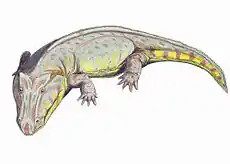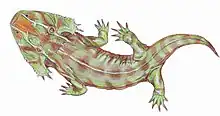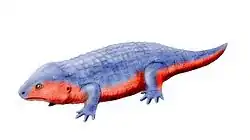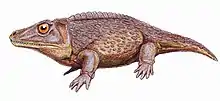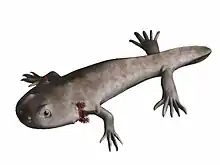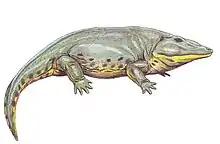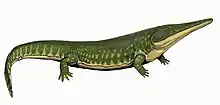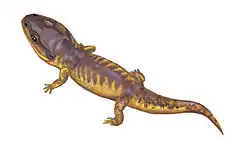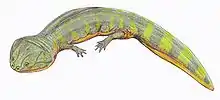| Conjunctio Temporal range: Lower Permian | |
|---|---|
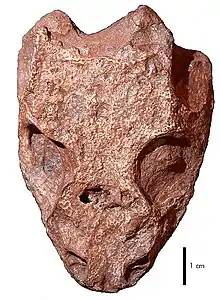 | |
| Scientific classification | |
| Domain: | Eukaryota |
| Kingdom: | Animalia |
| Phylum: | Chordata |
| Class: | Amphibia |
| Order: | †Temnospondyli |
| Family: | †Dissorophidae |
| Genus: | †Conjunctio Carroll, 1964 |
| Type species | |
| †Cunjunctio multidens | |
Conjunctio is an extinct genus of dissorophid temnospondyl amphibian from the early Permian of New Mexico. The type species, Conjunctio multidens, was named by paleontologist Robert L. Carroll in 1964.
History of study
The holotype specimen was found in 1911 in the Lower Permian Abo Formation in New Mexico. It consists of the skull and postcranial material including femora, humeri, scapulae, pelvis, a section of the vertebral column, and osteoderms. It was originally described by Case et al. (1913) as a referred specimen of Aspidosaurus (sometimes "Broiliellus") novomexicanus but was subsequently determined to be a distinct species by Carroll (1964).[1][2] Carroll also identified a third specimen of Conjunctio, which he did not refer specifically to C. multidens; this was subsequently referred to as the "Admiral Taxon" (because it came from the Admiral Formation of Texas) by most workers until it was formalized as a distinct genus and species, Scapanops neglecta, by Schoch & Sues (2013).[3] These authors also provided an updated description and illustration of C. multidens.
Phylogenetic position
Conjunctio is typically recovered as a basal eucacopine.[3]
| Dissorophidae |
| ||||||||||||||||||||||||||||||||||||||||||||||||||||||||||||
References
- ↑ Case, Ermine C.; Mehl, Maurice G.; Williston, Samuel W. (1913). Permo-Carboniferous vertebrates from New Mexico. Washington: Carnegie Institution of Washington.
- ↑ Carroll, Robert L. (1964). "Early evolution of the dissorophid amphibians". Bulletin of the Museum of Comparative Zoology. 131: 163–250 – via Biodiversity Heritage Library.
- 1 2 Schoch, Rainer R.; Sues, Hans-Dieter (2013). "A new dissorophid temnospondyl from the Lower Permian of north-central Texas". Comptes Rendus Palevol. 12 (7–8): 437–445. doi:10.1016/j.crpv.2013.04.002.
